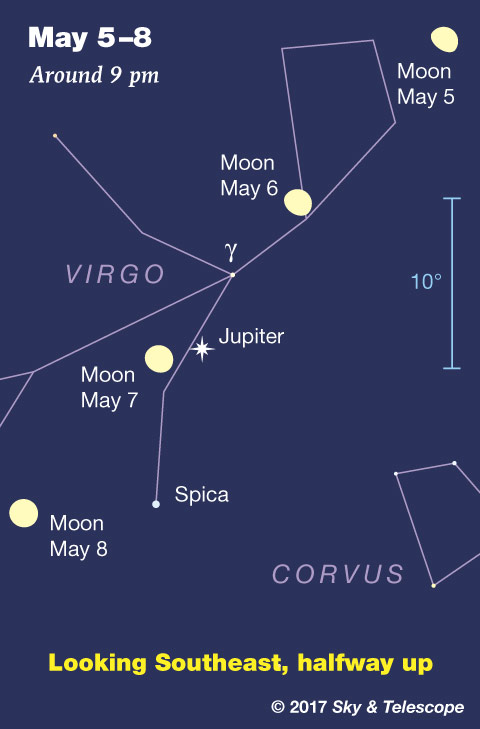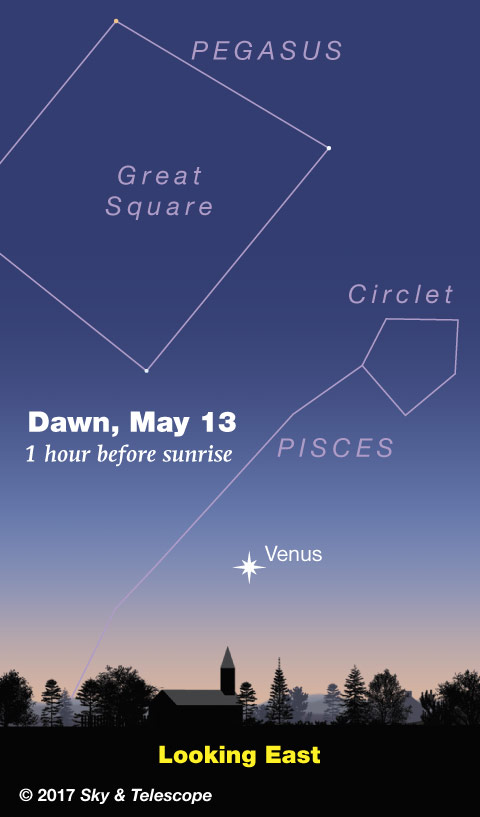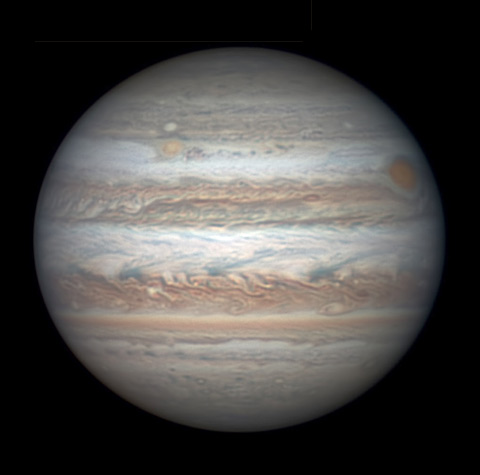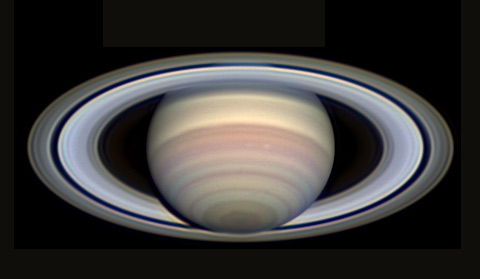
Friday, May 5
• Above the Moon tonight is Leo's tail star, Denebola (by about a fist at arm's length). Far to the Moon's lower left at dusk is bright Jupiter, with Spica farther on, as shown here.
Saturday, May 6
• The Moon tonight forms a gently curving arc with, to its lower left, bright Jupiter and then Spica, as shown here. Look between the Moon and Jupiter for 3rd-magnitude Gamma (γ) Virginis, also called Porrima, a fine, close telescopic double star.
• Summer is more than six weeks away, but the Summer Triangle is beginning to make its appearance in the east, one star after another. The first up in view is Vega. It's already visible low in the northeast as twilight fades.
Next up is Deneb, lower left of Vega by two or three fists at arm's length. Deneb rises about an hour after Vega does, depending on your latitude.
Third to rise is Altair, which shows up far to their lower right around midnight.
Sunday, May 7
• The bright light just a few degrees from the Moon tonight is Jupiter. Ten degrees below or lower left of them lurks blue-white Spica, as shown above.
Monday, May 8
• These spring evenings, the long, dim sea serpent Hydra snakes level far across the southern sky. Find Hydra's head, a rather dim asterism about the width of your thumb at arm's length, in the southwest. (It's lower right of Regulus by about two fists at arm's length. Also, a line from Castor through Pollux points to it 2½ fists away.) Hydra's tail stretches all the way to Libra, rising in the southeast. Hydra's star pattern, from forehead to tail-tip, is 95° long.
Tuesday, May 9
• At dusk, the Moon forms a nearly equilateral triangle, about 30° on a side, with Arcturus to its upper left and Jupiter to its upper right. Watch the triangle rotate clockwise as it moves across the sky through the night.
Wednesday, May 10
• Full Moon (exactly full at 5:42 p.m. EDT). The Moon rises around sunset and shines in Libra all through the night. Nearly 40° above it shines Arcturus.

Thursday, May 11
• A Jupiter double-shadow event for telescopes: Io and Europa cast their two tiny black shadows onto opposite sides of Jupiter's face from 9:59 to 10:05 p.m. Eastern Daylight Time.
• As evening grows late, look about 10° below the Moon for orange-red Antares twinkling away. Lesser stars of Scorpius are scattered around and upper right of Antares. By midnight, Saturn is glowing to the lower left of them all.
Even later in the night, look for Saturn glowing steadily to the lower left of all of them.
Friday, May 12
• The Arch of Spring spans the western sky in late twilight. Pollux and Castor form its top: they're lined up roughly horizontally in the west-northwest, about three finger-widths at arm's length apart. Look far to their lower left for Procyon, and farther to their lower right for Menkalinan and then bright Capella. The Arch of Spring is the last departing section of the even bigger Winter Hexagon.
Saturday, May 13
• Three zero-magnitude stars shine after dark in May: Arcturus high in the southeast, Vega much lower in the northeast, and Capella in the northwest. They appear so bright because each is at least 60 times as luminous as the Sun, and because they're all relatively nearby: 37, 25, and 42 light-years from us, respectively.
________________________
Want to become a better astronomer? Learn your way around the constellations! They're the key to locating everything fainter and deeper to hunt with binoculars or a telescope.
This is an outdoor nature hobby. For an easy-to-use constellation guide covering the whole evening sky, use the big monthly map in the center of each issue of Sky & Telescope, the essential guide to astronomy.

Once you get a telescope, to put it to good use you'll need a detailed, large-scale sky atlas (set of charts). The basic standard is the Pocket Sky Atlas (in either the original or Jumbo Edition), which shows stars to magnitude 7.6.
Next up is the larger and deeper Sky Atlas 2000.0, plotting stars to magnitude 8.5; nearly three times as many. The next up, once you know your way around, is the even larger Uranometria 2000.0 (stars to magnitude 9.75). And read how to use sky charts with a telescope.
You'll also want a good deep-sky guidebook, such as Sue French's Deep-Sky Wonders collection (which includes its own charts), Sky Atlas 2000.0 Companion by Strong and Sinnott, or the bigger Night Sky Observer's Guide by Kepple and Sanner.
Can a computerized telescope replace charts? Not for beginners, I don't think, and not on mounts and tripods that are less than top-quality mechanically (meaning heavy and expensive). And as Terence Dickinson and Alan Dyer say in their Backyard Astronomer's Guide, "A full appreciation of the universe cannot come without developing the skills to find things in the sky and understanding how the sky works. This knowledge comes only by spending time under the stars with star maps in hand."
This Week's Planet Roundup


Mercury is hidden deep in the glow of sunrise.
Venus (magnitude –4.7) shines low in the east as dawn brightens. In a telescope it's a thick crescent, shrinking week by week as it waxes.
Mars (magnitude +1.6, in Taurus) is finally sinking away in the western evening twilight after a year-long apparition. Look for it very far lower left of bright Capella high in the northwest. Don't confuse Mars with Aldebaran, which twinkles increasingly far down to Mars's lower left.
Jupiter (magnitude –2.4, in Virgo) shines high and bright in the southeast at dusk, with Spica 10° below it. Jupiter is highest for best telescopic viewing by about 10 or 11 p.m. daylight saving time, with Spica now to its lower left.
Saturn (magnitude +0.2, in Sagittarius) rises around 10 or 11 p.m. and glows highest in the south before dawn. Redder Antares (magnitude +1.0) twinkles 18° to Saturn's right in the early-morning hours.
Uranus is hidden in the sunrise.
Neptune is still too low before dawn.
__________________________
All descriptions that relate to your horizon — including the words up, down, right, and left — are written for the world's mid-northern latitudes. Descriptions that also depend on longitude (mainly Moon positions) are for North America.
Eastern Daylight Time (EDT) is Universal Time (UT, UTC, or GMT) minus 4 hours.
__________________________
"This adventure is made possible by generations of searchers strictly adhering to a simple set of rules. Test ideas by experiments and observations. Build on those ideas that pass the test. Reject the ones that fail. Follow the evidence wherever it leads, and question everything. Accept these terms, and the cosmos is yours."
— Neil deGrasse Tyson, 2014
"Objective reality exists. Facts are often determinable. Vaccines do stop diseases. Carbon dioxide does warm the globe. Science and reason are no political conspiracy; they are how we discover reality. Civilization's survival depends on our ability, and willingness, to do so."
— Alan MacRobert, your Sky at a Glance editor
"Facts are stubborn things; and whatever may be our wishes, our inclinations, or the dictates of our passions, they cannot alter the state of facts and evidence."
— John Adams, 1770
 1
1








Comments
Anthony Barreiro
May 5, 2017 at 6:02 pm
Today, May 5, the Sun is half way from the Spring Equinox to the Summer Solstice. So if the Solstice is Midsummer Day, today is the first day of Summer. It sure feels to me like Summer is already here. Since the year is a cycle, any way of dividing it up will be arbitrary. But the Solstices and Equinoxes feel a lot more like the climaxes of their respective seasons than the beginnings of the seasons.
You must be logged in to post a comment.
You must be logged in to post a comment.